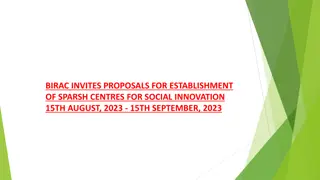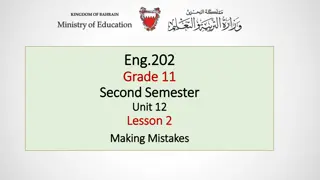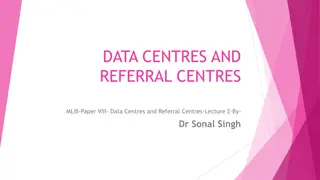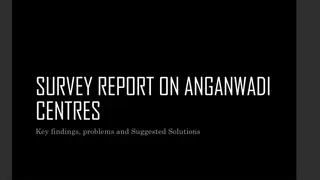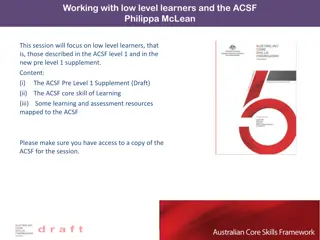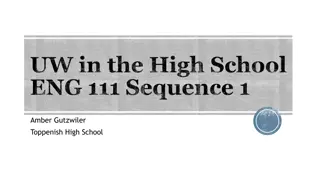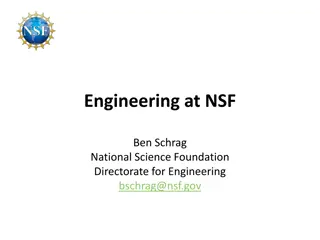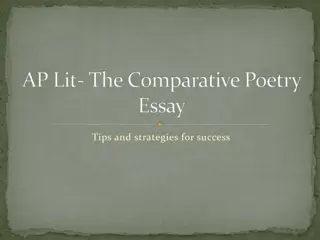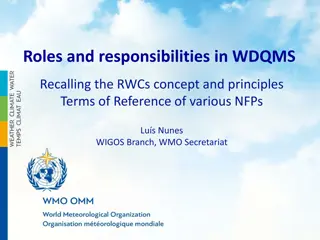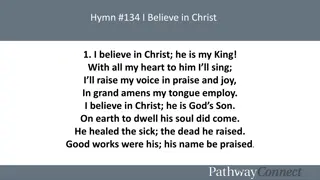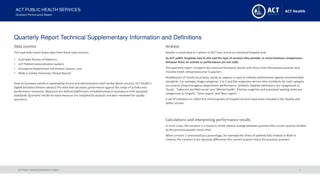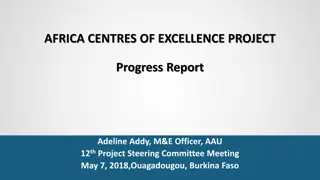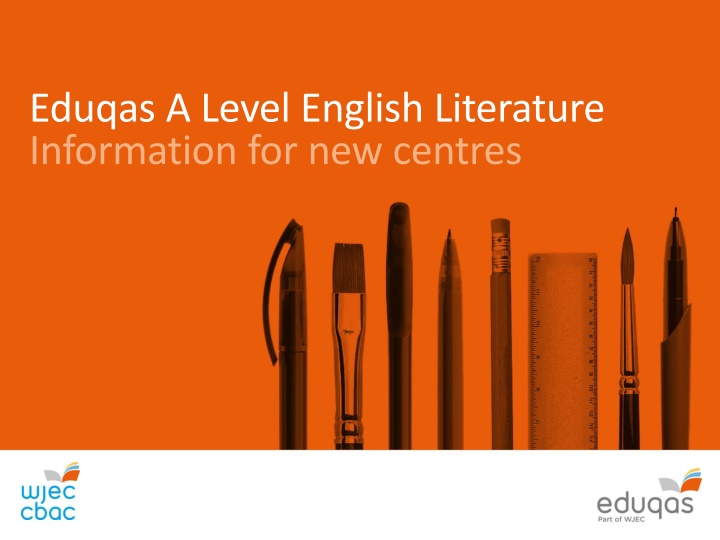
Understanding Eduqas A Level English Literature Course
Explore the Eduqas GCE English Literature course focusing on literary genres, historical contexts, and reception of texts. The course is structured around poetry, drama, unseen texts, and prose, enabling students to analyze and appreciate literature within its genre and literary tradition.
Download Presentation

Please find below an Image/Link to download the presentation.
The content on the website is provided AS IS for your information and personal use only. It may not be sold, licensed, or shared on other websites without obtaining consent from the author. If you encounter any issues during the download, it is possible that the publisher has removed the file from their server.
You are allowed to download the files provided on this website for personal or commercial use, subject to the condition that they are used lawfully. All files are the property of their respective owners.
The content on the website is provided AS IS for your information and personal use only. It may not be sold, licensed, or shared on other websites without obtaining consent from the author.
E N D
Presentation Transcript
Eduqas A Level English Literature Information for new centres
Ethos The Eduqas GCE English Literature course looks at the ways literary writers make meaning in different genres, how these meanings relate to the time in which they were written, and how the texts have been received since then. Students will develop the skill of engaging with literature personally as well as seeing it as a product of its time and an example of its genre and literary tradition.
Overview The course is divided into the three main literary genres, other than the unseen text component which has a synoptic element: Component 1: Poetry Component 2: Drama Component 3: Unseen texts (prose and poetry) Component 4: Prose (non-exam assessment) This is so that students can focus on the nature of the specific genres and the typical features of those genres as well as how they differ within that genre due to their contexts.
Specification Content in brief Component 1 Poetry A: One pre 1900 Poet 30% 2 hours B: Two post 1900 poets Component 2 Drama A: One Shakespeare play 30% 2 hours B: Two other drama texts: one pre 1900 and one post 1900 Component 3 Unseen texts A: One prose extract from a specified time period 20% 2 hours B: One poem Component 4 Prose One 2500-3500 word study of two prose texts: one pre 2000 and one post 2000 20%
Text Choices for Component 1 Section A:Poetry pre-1900 (open- book, clean copy) Section A is based on the study of one pre-1900 poetry text from the list below: Geoffrey Chaucer: The Merchant s Prologue and Tale (Cambridge) *John Donne: Selected Poems (Penguin Classics) John Milton: Paradise Lost Book IX (Oxford) *John Keats: Selected Poems (Penguin Classics) (for assessment in summer 2020 and 2021 only) * William Blake: Poems selected by Patti Smith (Vintage) (for assessment from summer 2022 onwards) *Christina Rossetti: Selected Poems (Penguin Classics) *Prescribed poems for study of Donne, Keats (to 2021), Blake (from 2022) and Rossetti are listed in the Specification Appendix B.
Text choices for Component 1 Section B: Poetry post-1900 (open- book, clean copy) Section B is based on the study of two post-1900 paired poetry texts from the list below: Thomas Hardy: Poems selected by Tom Paulin (Faber) (Prescribed sections: Poems of the Past and Present, Poems of 1912-13, Moments of Vision) & T S Eliot: Selected Poems (Faber) (Prescribed sections: Prufrock and Other Observations, The Waste Land, The Hollow Men, Ariel Poems) D H Lawrence: Selected Poems (Penguin Classics, edited by James Fenton) (Prescribed sections: Love Poems and Others, Amores, New Poems, Birds, Beasts and Flowers, Last Poems) & Gillian Clarke: Making the Beds for the Dead (Carcanet) (for assessment in summer 2020 and 2021 only) W. B. Yeats: Poems selected by Seamus Heaney (Faber) (prescribed sections: In the Seven Woods, The Green Helmet and Other Poems, Responsibilities, The Wild Swans at Coole, Michael Robartes and the Dancer, The Tower) & Dannie Abse: Welsh Retrospective (Seren) (for assessment from summer 2022 onwards) Ted Hughes: Poems selected by Simon Armitage (Faber) (Prescribed section: all poems up to and including 'Rain' on page 68) & Sylvia Plath: Poems selected by Ted Hughes (Faber) Philip Larkin: The Whitsun Weddings (Faber) & Carol Ann Duffy: Mean Time (Picador) Seamus Heaney: Field Work (Faber) & Owen Sheers: Skirrid Hill (Seren)
Text choices for Component 2 Section A: Shakespeare (closed book) Section A is based on the study of one Shakespeare play from the list below: King Lear Antony and Cleopatra Hamlet Henry IV Part 1 The Tempest
Text choices for Component 2 Section B: Drama (closed book) Section B is based on the study of a pair of plays, one pre-1900 play and the other post-1900, from the list below: Christopher Marlowe: Doctor Faustus (Longman) & Lucy Prebble: Enron (Methuen) John Webster: The Duchess of Malfi (Methuen) & Tennessee Williams: A Streetcar Named Desire (Penguin Modern Classics) Thomas Middleton: The Revenger s Tragedy (Methuen) & Joe Orton: Loot (Methuen) Oscar Wilde: Lady Windermere s Fan (New Mermaids) & Harold Pinter: Betrayal (Faber) William Shakespeare: Measure for Measure (any edition) & David Hare: Murmuring Judges (Faber)
Texts for Component 3 Unseen texts Section A: Unseen prose Students will respond to one question from a choice of two. Each question will offer an unseen prose passage for analysis. Question 1 will take a prose passage from the period 1880-1910. Question 2 will take a prose passage from the period 1918-1939. Students should study a range of extracts from across these periods, although many schools and colleges focus on one period. Section B: Unseen poetry Students will respond to one question from a choice of two. Each question will be based on an unseen poem from any period.
Texts for Component 4 Prose Study NEA Students will produce a 2500-3500 word assignment based on the reading of two prose texts by different authors, one published pre-2000 and one published post- 2000. Both texts must be nominated and submitted via WJEC's secure website for approval by the end of September in the year prior to submission. Texts must be substantial and of sufficient literary merit for A level study. For the purposes of this component, the term 'prose text' will be taken to include the novel, acollection of short stories, autobiography and memoir, travel writing and essays. Our Subject Officer, Rhodri Jones, will be happy to advise on making suitable text choices.
Assessment objectives AO1 Articulate informed, personal and creative responses to literary texts, using associated concepts and terminology, and coherent, accurate written expression AO2 Analyse ways in which meanings are shaped in literary texts AO3 Demonstrate understanding of the significance and influence of the contexts in which literary texts are written and received AO4 Explore connections across literary texts AO5 Explore literary texts informed by different interpretations.
Assessment objectives across the specification AO1 AO2 AO3 AO4 AO5 Total Component 1 7.5% 10% 5% 2.5% 5% 30% Component 2 5% 7.5% 7.5% 5% 5% 30% Component 3 7.5% 7.5% 2.5% 2.5% 20% Component 4 5% 5% 5% 2.5% 2.5% 20% Overall 25% 30% 20% 10% 10% 100% This table shows that AO2 analyse ways in which meanings are shaped in literary texts is the AO that should drive all responses. In other words, the analysis of the primary text/s should be at the heart of all responses.
Assessment by component Component 1 Poetry Section Topic Approach Mark AOs Section A Pre-1900 poet (open book) Two part question Response to named poem 20 AO1 (10) AO2 (10) Essay 40 AO1 (10) AO2 (10) AO3 (10) AO5 (10) Section B Post-1900 poets (paired) (open book) One essay from a choice of two questions 60 AO1 (10) AO2 (20) AO3 (10) AO4 (10) AO5 (10)
Assessment by component Component 2 Drama Section Topic Approach Mark AOs Section A Shakespeare (closed book) Two part question Response to an extract 15 AO1 (5) AO2 (10) Essay 45 AO1 (5) AO2 (10) AO3 (20) AO5 (10) Section B Drama texts (paired) (closed book) One essay from a choice of two questions 60 AO1 (10) AO2 (10) AO3 (10) AO4 (20) AO5 (10)
Assessment by Component Component 3 Unseen texts Section Topic Approach Mark AOs Section A Unseen prose Response to one extract from a choice of two (either 1880- 1910 or 1918-1939) 50 AO1 (15) AO2 (15) AO3 (10) AO5 (10) Section B Unseen poetry Response to one poem from a choice of two 30 AO1 (15) AO2 (15)
Assessment by Component Component 4 Prose study Section Topic Approach Mark AOs Non-exam assessment Prose study based on one pre and one post 2000 novel One 2500-3000 word essay 80 AO1 (20) AO2 (20) AO3 (20) AO4 (10) AO5 (10)
Study by Genre A key advantage of organising the components by literary genre is that students can focus on the characteristics of each genre and how meaning is made specifically in the different forms of literary expression. This means that they can focus on the stylistic features that are most relevant to each genre. The Terminology Toolkit has a range of literary terminology associated with the genres but students must remember that terminology is just a label to aid them in analysing texts.
Focus Poetry Drama Prose themes/ideas voice structure language tone imagery sound title how the poem ends themes/ideas dramatic techniques: lighting, sound, props etc. set staging: the position of the actors on stage, in relation to one another etc. character dialogue structure of the scene and play themes/ideas narrative voice language structure motifs character settings tone
Knowing the assessment objectives Although students should be aware of the assessment objectives and their weightings, there is no need for them to memorise these or force in content to meet a particular AO. The questions are written so that if a student answers the specific question they will be addressing the AOs. For example: With close reference to relevant contexts, discuss the view that Shakespeare s greatest achievement in the play King Lear is to make us feel for the old, the poor and the outcast . [45]
How the marking works Each question/assessment is marked in five bands, with band 5 being the highest. The key words in each band are as follows: Band 5 Sophisticated, perceptive, mature, confident, illuminating Band 4 Sound, secure, purposeful Band 3 Sensible, relevant, organised, clear Band 2 Some (relevance, grasp) Band 1 Superficial, basic, descriptive
Exam questions: common approaches Time is needed to identify the strands/focus of the specific question and to planning in order to avoid overlong, unfocused answers. Be wary of using linguistic terminology or even literary terminology without any discussion of impact/effect. Context should be varied and students should be wary of over using biographical context. Different interpretations are best done through critical engagement with the question. Critical quotes can be used where relevant but students should be wary of making generalisations about general literary critical approaches. You can use the search facility to find past papers and mark schemes
Sample questions: Component 1 Section A Pre 1900 poet (20 minutes/40 minutes) John Donne: Selected Poems (Penguin Classics) 2. (i) Re-read Holy Sonnet III ( O might those sighs and tears return again ) on page 178. Analyse Donne s presentation of guilt in this poem. [20] (ii) We can experience both pleasure and enlightenment in reading Donne s poetry without sharing all of his attitudes and beliefs. With close reference to relevant contexts, show how far you agree with this comment. [40] Extract/given poem question has clear focus on presentation of guilt (AO1 and AO2 assessed) Essay clearly draws attention to context and different interpretations (AO1, AO2, AO3, AO5 assessed) For the essay, students should write about 2 or 3 poems (and are advised not to use the poem given in part i)
Sample questions: Component 1 Section B Paired post 1900 poets (1 hour) Philip Larkin: The Whitsun Weddings (Faber) Carol Ann Duffy: Mean Time (Picador) Either, 12. Some readers have found that while both Larkin and Duffy write in a period of increasing material prosperity, both share a preoccupation with failure and lost opportunities . In exploring connections between the poets work, and with close reference to relevant contexts, show how far you agree with this comment. You must analyse in detail at least two poems from each of your set texts. [60] Or, 13. With close reference to relevant contexts, how far would you agree that Larkin s and Duffy s poetry is alike in that personal lives are presented as tests of endurance rather than as celebrations of joy ? You must analyse in detail at least two poems from each of your set texts. [60] Again, focusing on all the key words in the question will lead students to covering the AOs. The most successful way of dealing with the number of poems here is to write about two complementary pairs i.e. one Larkin compared with one Duffy and then a different Larkin compared with a different Duffy.
Approaching the poetry questions Highlight key words in the question. Formulate an argument/overview in response to the question. For the section A given poem, select parts of the poem carefully and with clear focus on the question. There is no time to track the whole poem. For section B, select poems carefully based on comparison and spend some time planning your answer based on key comparative elements. Terminology, or techniques , should be poetry specific. They should not be simply labels of linguistic or literary devices. While this component has been covered in all previous CPD sessions, the 2019-20 CPD session focused specifically on poetry and there are many useful resources and teaching activities under the Autumn 2019 CPD tab.
Sample questions: Component 2 Section A Shakespeare (20 minutes/40 minutes) King Lear (i) With close reference to the language and imagery in this extract, examine how Shakespeare presents King Claudius at this point in the play. [15] (ii) The play Hamlet persuades us that there is a powerful connection between personal and political instability. Examine this view of the play. Your response must include close reference to relevant contexts. [45] Timings are the same as component 1. Extract has a clear focus and essay reminds students that this is a play and that they must refer to contexts.
Sample questions: Component 2 Section B Paired Drama texts (1 hour) Webster: The Duchess of Malfi (Methuen) Williams: A Streetcar Named Desire (Penguin Modern Classics) Either, 8. The abuse of power is the primary focus of this play. To what extent could you apply this view to both The Duchess of Malfi and A Streetcar Named Desire? Your response must include close reference to relevant contexts. [60] Or, 9. How far do you agree that in these two plays, both Webster and Williams present an unhealthy society ruled by intolerance and prejudice ? Your response must include close reference to relevant contexts. [60]
Approaching the drama questions Highlight key words in the question. Formulate an argument/overview in response to the question. For section A extract, select evidence carefully and with clear focus on the question. There is no time to track the whole extract. For section B, spend some time planning your answer based on key comparative elements. Terminology, or techniques , should be drama specific. They should not be simply labels of linguistic or literary devices. You will notice that the suggested approaches here are exactly the same as those for Component 1. This Teaching Shakespeare and Drama digital resource has a range of teaching activities and notes concentrating on the texts as dramatic performances.
Exam papers: Component 3 Section A Unseen prose (1 hour 15 minutes) Students are given the choice of two prose extracts, one from 1880-1910 and one from 1918-1939. Each extract has two brief supporting extracts . These are critical comments designed to give students a way in to the text and to enable them to cover AO3 (context) and AO5 (different interpretations). Using the supporting extracts as a starting point, students should read the prose text carefully to identify the most relevant areas to analyse. Students should use their knowledge of prose texts from their NEA study to inform the aspects that are most relevant to a prose study, such as narrative voice, narrative structure, characterisation, setting etc Students will know some broad context of the period they have studied and they may have studied some critical viewpoints on literature of that period, but the given supporting extracts are the best way to deal with both AO3 and AO5. (View past papers) The Analysing Unseen Prose resource for approaching this section can be found in Eduqas Digital Resources.
Exam papers: Component 3 Section B Unseen poetry (45 minutes) Students choose one poem from a choice of two and give a literary analysis of their chosen poem. They should use their knowledge of poetry from Component 1 and because this question tests only AO1 and AO2 they should have a clear focus on how the poet creates meaning. During teaching of Component 1, make sure that students treat some of the set poems as unseen so that this skill is developing. It is really important that students read the poem a number of times before starting their answer and that they realise that the poem may be challenging and may raise more questions than answers. In other words, they should not try to make the poem fit a reading and should be tentative in their responses. This Analysing Unseen Poetry resource for approaching this section can be found in Eduqas Digital Resources. In addition, the Autumn 2019 CPD resources mentioned earlier focus on poetry.
Component 4: Non-examination Assessment (NEA) Students will produce one 2500-3500 word prose study based on texts by two different authors, one pre 2000 and one post 2000. This encourages students to engage with contemporary texts. There are a number of ways to approach text choices, depending on the nature and size of your cohort: allow students free choice of texts (possibly from a given selection) teach one core text and offer a selection of partner texts teach both texts (ensuring that students have individual tasks) Teachers should work very closely with students to create a relevant task that enables students to cover all AOs. There is significant guidance on creating and refining tasks in the materials from each previous CPD session and in the Guidance for Teaching handbook.
NEA Task setting Often characters in dystopian literature are on a quest for some sort of perfection. In light of this statement, compare and contrast the ways in which McCarthy and Atwood present perfection seeking in The Road and The Handmaid s Tale. In the course of your answer, you must consider the importance of relevant contextual influence on both texts. AO1 AO2 AO3 AO4 AO5
NEA Task setting template Statement on the theme that is interesting enough and relates to both texts. In light of this statement, compare and contrast the ways in which ____________ and ____________ present ____________ in ________________ and _______________. In the course of your answer, you must consider the importance of relevant contextual influences on both texts.
Teaching the course Because teachers of A Level English Literature work in varied scenarios, this course is being delivered in many different ways by schools and colleges using the specification. It is probably a good idea, before launching into set texts, for students to understand what literature is and how we study literature before considering how the three genres work. The Guidance for Teachers has comprehensive advice and ideas for teaching. In Eduqas Digital Resources, we have a number of resources designed to help students develop an academic style, to write concisely and to incorporate contexts and other interpretations effectively into their answers. If more than one teacher is delivering the course, these resources will also ensure that you are approaching these elements with consistency.
Using Online Exam Review (OER) to help your assessment OER allows you to look at student responses to past exam paper questions. You can view these as unmarked and marked. The statistical table shows you have many students answered each question, the mean mark for each question and how accessible that question was (the facility factor ). It can also be interesting to see which texts are popular and which question was most popular where there are choices. The left hand menu bar has a range of responses at different levels of achievement. There are instructions for accessing OER on the home screen.
Resources Guidance for teaching: starting point for activities, resources and advice to help plan the course Past papers and mark schemes Resources: including examiners reports, assessment grids, exemplar responses, grade boundaries, key dates, FAQs etc Digital resources for classroom use CPD materials from all previous CPD sessions Online exam review WJEC Secure website for your results data and access to additional NEA exemplars and guidance
Any Questions? Contact our specialist Subject Officers and administrative team for your subject with any queries. Rhodri Jones: Subject Officer Mike Williams / Fleur Saddler: Subject Support Officers gceenglish@eduqas.co.uk 029 2240 4292 @eduqas eduqas.co.uk


